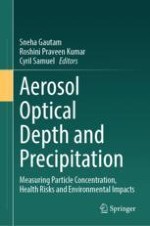2024 | OriginalPaper | Buchkapitel
Comparative Health Risk Assessment of Black Carbon and Particulate Matter Emissions in East India During the COVID-19 First and Second Waves
verfasst von : Dilip Kumar Mahato, Balram Ambade
Erschienen in: Aerosol Optical Depth and Precipitation
Verlag: Springer Nature Switzerland
Aktivieren Sie unsere intelligente Suche, um passende Fachinhalte oder Patente zu finden.
Wählen Sie Textabschnitte aus um mit Künstlicher Intelligenz passenden Patente zu finden. powered by
Markieren Sie Textabschnitte, um KI-gestützt weitere passende Inhalte zu finden. powered by
